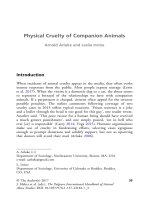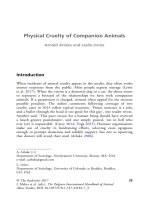The palgrave international handbook of a 51
Bạn đang xem bản rút gọn của tài liệu. Xem và tải ngay bản đầy đủ của tài liệu tại đây (36.91 KB, 1 trang )
Physical Cruelty of Companion Animals
Arnold Arluke and Leslie Irvine
Introduction
When incidents of animal cruelty appear in the media, they often evoke
intense responses from the public. Most people express outrage (Levin
et al. 2017). When the victim is a domestic dog or a cat, the abuse seems
to represent a betrayal of the relationships we have with companion
animals. If a perpetrator is charged, citizens often appeal for the strictest
possible penalties. The online comments following coverage of two
cruelty cases in 2015 reflect typical reactions. ‘Prison sentence is a joke
and a bullet through the head is too good for this guy’, one reader wrote.
Another said, ‘This poor excuse for a human being should have received
a much greater punishment’, and one simply posted, ‘rot in hell who
ever [sic] is responsible’ (Carey 2014; Vega 2015). Humane organisations
make use of cruelty in fundraising efforts, selecting cases egregious
enough to prompt donations and solidify support, but not so upsetting
that donors will avoid their mail (Arluke 2006).
A. Arluke (*)
Department of Sociology, Northeastern University, Boston, MA, USA
e-mail:
L. Irvine
Department of Sociology, University of Colorado at Boulder, Boulder,
CO, USA
© The Author(s) 2017
J. Maher et al. (eds.), The Palgrave International Handbook of Animal
Abuse Studies, DOI 10.1057/978-1-137-43183-7_3
39









